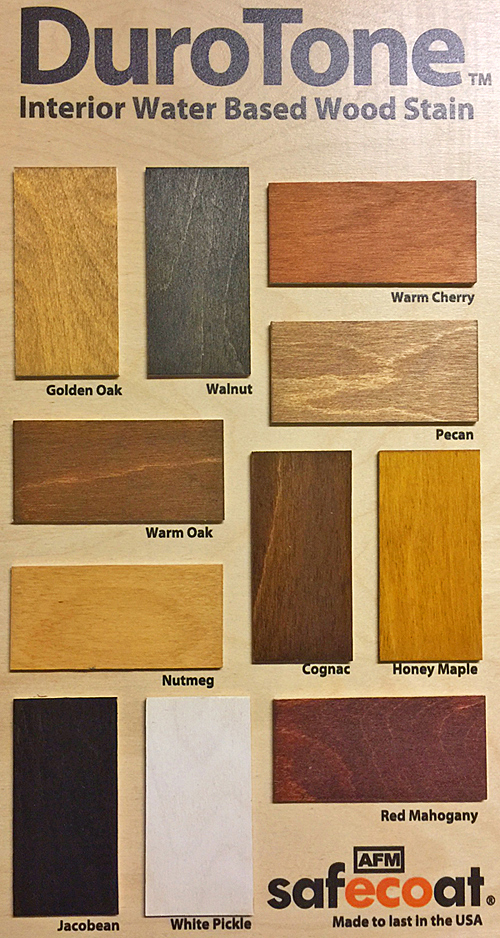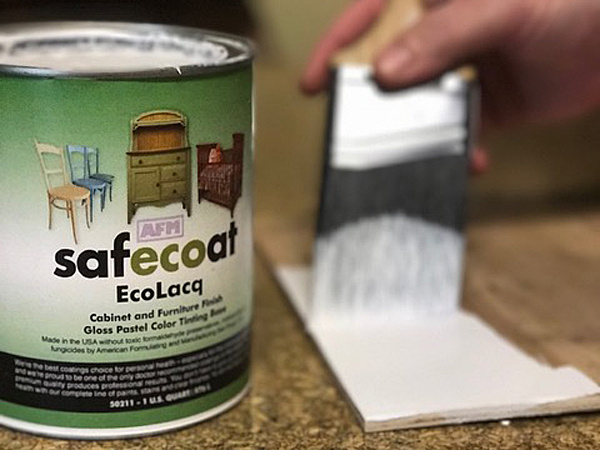
Today’s building products, which include the paints, stains and finishes we use for woodworking and DIY, are a chemical soup, according to Andrew Pace, founder of The Green Design Center/Building for Health. And some of the ingredients in those “soup” recipes, ironically, are actually safer for the environment than they are for people.
“There are around 92,000 chemicals used in the production of building materials and home goods,” he says. “Out of those, only 3 percent have ever been tested for their toxicological effects on humans. Three percent!”

That’s in part because the Environmental Protection Agency, which started regulating volatile organic compounds (VOCs) back in the 1990s, did so to help control smog — low-level smog can form when VOCs react with nitrogen and UV light. Making building products safer for people wasn’t an EPA goal for regulating VOCs.
Instead, Pace says the EPA has actually exempted 37 VOCs that are highly dangerous to people but don’t contribute to smog. Those include ammonia, acetone and butyl acetate, which are commonly used in consumer paints, including those marketed as zero-VOC “green” products.

“Legally, these coatings can then be called “green” because they are zero-VOC. But in actuality, they are just as harmful to humans or in some cases, even more harmful than the old oil-based products,” Pace says.
And if these chemicals are harmful to those with healthy immune systems, they are even more problematic for those with allergies, asthma, chemical sensitivities and even Autism. While the presence of these toxins in certain paints and finishes presents unhealthy exposure levels when first applied, their toxicity doesn’t necessarily go away after they dry, either.

“Most paints and coatings will release unreacted chemical monomers (called outgassing) for two to five years AFTER achieving a full cure,” Pace says.
But a safer family of paints, stains and wood finishes does exist, and so do some 7,000 other products that Pace and his company have been distributing for more than 25 years. “There is a healthy alternative to just about anything that goes into a new home, and we sell these materials as DIY projects or offer installation services if you need it.”
For instance, since 2008 GDC/Building for Health has been the master distributor of AFM Safecoat paints and finishes, and Pace has carried the AFM line since 1992. Southern California-based AFM Safecoat has been making its family of around 50 products since the 1980s, before the term “VOC” was even part of our environmental vernacular. A paint chemist named Nester Noe created AFM Safecoat paint, after he developed lung cancer late in his career that he attributed to decades of industrial chemical exposure.
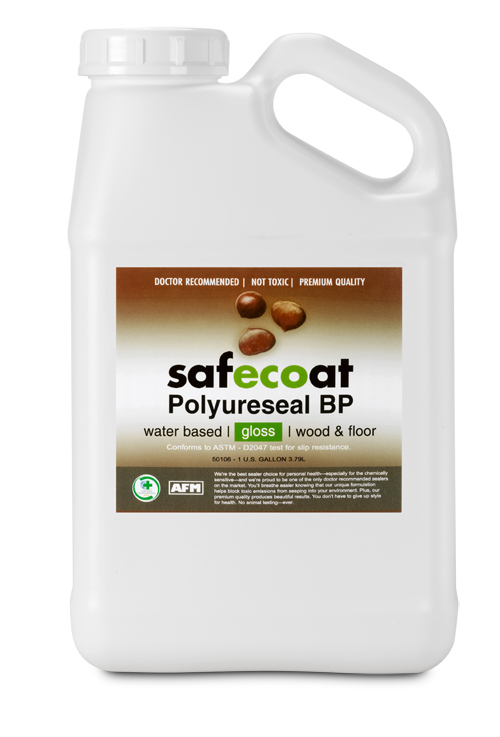
“He made it his life mission to develop formulations that didn’t require the use of health hazards and toxins,” Pace says. And that mission continues today. “AFM prides itself on making high-quality DIY and professional products that are easy to use, long lasting and most importantly, essentially free of health hazards or toxins.”
Pace adds that AFM’s primers, clear coats and stains are also specifically formulated to seal themselves up and to not outgas once they reach a full cure.
If you aren’t already familiar with the product line, Pace would like to direct our attention to a few AFM Safecoat options that should be particularly relevant to woodworking and DIY.
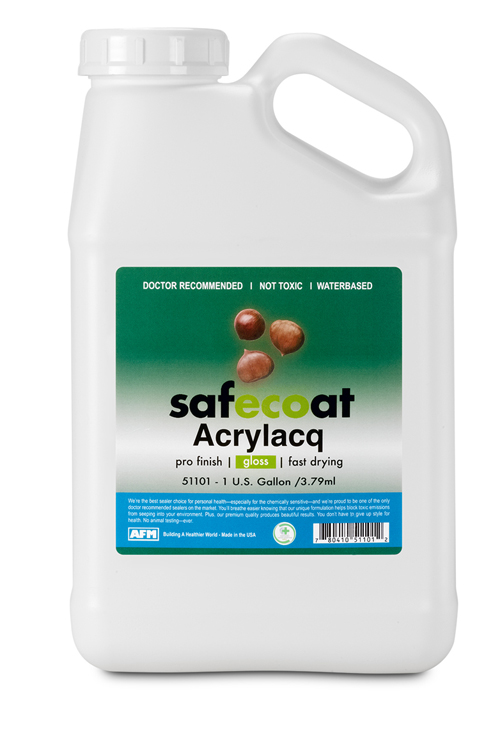
AFM Safecoat ZVOC Paint is formulated in both transitional primer and paint options. You can buy the paint for either interior or exterior applications, and it’s available in four sheens: flat, pearl, eggshell and semi-gloss. It contains no formaldehyde, ammonia, crystalline silica or ethylene glycol. GDC/Building for Health offers ZVOC Paint in a full spectrum of colors, which can be selected using a color palette on the company’s website. The paints and primer have almost no odor during application and are odor-free once cured, drying to a hard, scrubbable enamel finish. Interior and exterior paints start in the $55 per gallon range, and the prices increase based on sheen and/or depth of color. They also are tintable to other paint brand colors.
Pace adds that Safecoat paint is considered a premium grade. “You’ll get sick of the color before you ever have to repaint due to durability issues.”
AFM also provides a solution for woodworkers and DIYers looking for a low-odor, low-toxicity alternative to water- or oil-based polyurethane varnish. It’s called AFM PolyureSeal BP. A water-based clear finish, it’s suitable for either raw or previously finished wooden surfaces, such as furniture, cabinetry and floors. It has a high solids content for durability, and it doesn’t contain solvents or isocyanates and ethylene glycol that are used in some conventional water-based poly formulations. You can buy it in gloss or satin sheen, and it sells for around $38 per quart.
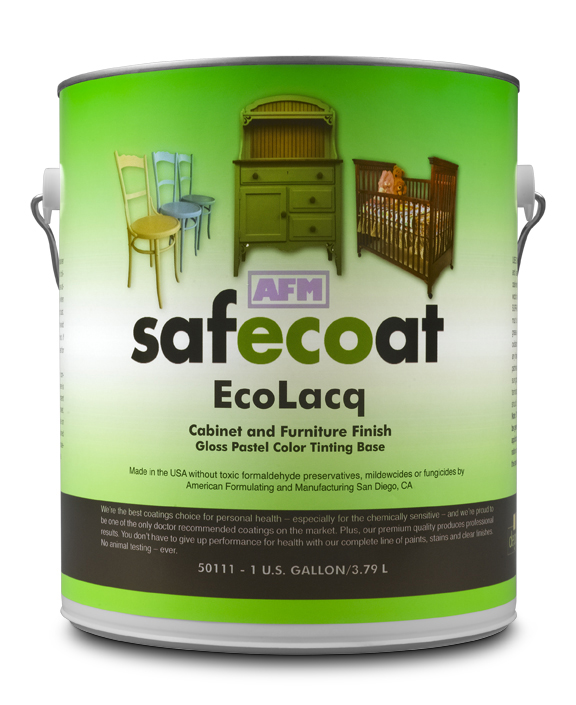
“(PolyureSeal BP) has also been tested to completely eliminate formaldehyde off-gassing if used on traditional plywood. All AFM coatings are capable of sealing up chemical off-gassing, but the Poly has been tested to 100 percent effectiveness,” Pace reports. “Whether you are using a synthetic applicator pad for a hardwood floor, or if you are spraying it on cabinetry, AFM PolyureSeal BP will be the most durable, long-lasting toxin free coating you will ever use.”
Lacquer continues to be a popular finish among woodworkers, despite its high solvent content, flammability and environmental impacts. But, AFM Acrylac — a water-based, clear acrylic — can offer a solvent-free, safer alternative to conventional lacquer, Pace suggests. “Acrylac is the single most popular product AFM sells, and it’s extremely versatile and easy to use. We sell it to cabinet and furniture makers, papier-mache artists, luthiers, homeowners … you name it.”

Available in either gloss or satin sheens, Acrylac can be sprayed or brushed and sells for around $38 per quart. Pace adds that AFM now also offers a tintable Acrylac-based paint called EcoLacq, which uses the same pigments as Safecoat paints.
And for those of us who appreciate the “close to the wood” look and convenience of wipe-on Danish oils, AFM manufactures a penetrating oil finish called AFM Naturals Oil Wax. “What makes AFM Naturals Oil Wax unique is that it uses all organically sourced plant oils and natural waxes, along with a pharmaceutical grade solvent called isoaliphate: this solvent prevents the oils from drying in the can and allows them to penetrate deeper into the pores of the wood once applied,” Pace says. Isoaliphate does not smell, leave a residue and is not a skin-sensitizing agent, he adds.
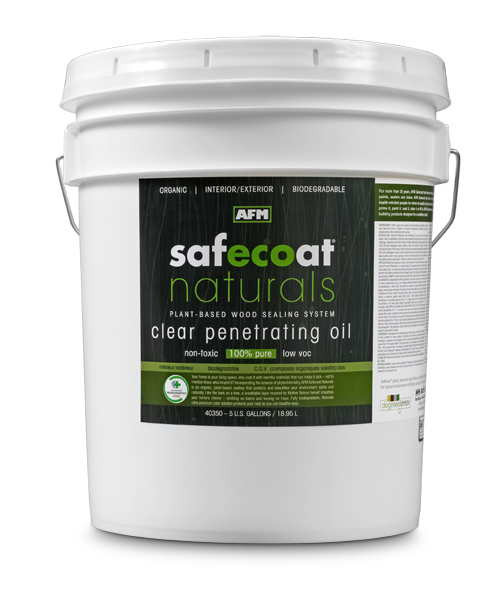
GDC/Building for Health offers other safer wood finishing products too, including AFM’s line of DuroTone Wood Stains and Clear Penetrating Oil, a tung oil and citrus solvent blend for food-safe use, decorative waxes, crackle paint and thinner. Learn more about those on the company’s website.
What started for Pace as search for a safer water-based epoxy coating in 1991 has evolved into a mission to provide safer, low-toxicity products of all kinds for everyone. “Anybody can sell products, but I sell life-saving products,” Pace says. “When a customer calls up in tears and says they haven’t been able to paint a room in 20 years because of health issues, then they use Safecoat with great success … It’s truly a blessing.”
Explore GDC/Building for Health, AFM Safecoat solutions and other building products by clicking here.
